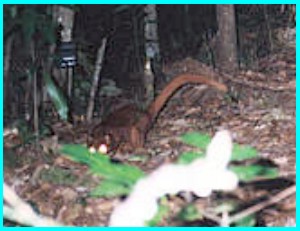
WWF
12-6-05
Gland, Switzerland – WWF researchers may have discovered a new, mysterious carnivore species in the dense, central forests of Borneo.12-6-05
The animal, a mammal slightly larger than a domestic cat with dark red fur and a long, bushy tail, was photographed twice by a camera trap at night. This could be the first time in more than a century that a new carnivore has been discovered on the island.
However, WWF researchers have not yet established whether this is an entirely new species or if it is a new species of marten or civet cat, which looks like a cross between a cat and a fox.
They are hoping to be able to confirm more about the discovery by setting cage traps and catching a live specimen.
“We showed the photos of the animal to locals who know the wildlife of the area, but nobody had ever seen this creature before,” said Stephan Wulffraat, a biologist who is coordinating WWF’s research on this species. “We also consulted several Bornean wildlife experts, some thought it looked like a lemur, but most were convinced it was a new species of carnivore."
WWF stresses that the strange animal, which also has very small ears and large hind legs, might remain a mystery for ever, if its habitat is not adequately protected.
Kayan Mentarang National Park in Kalimantan, where the carnivore was photographed, is located in the “Heart of Borneo”, a mountainous region covered with vast tracks of rainforest.
But plans announced by the Indonesian government in July to create the world’s largest palm oil plantation in this area would have a devastating impact on the forests, wildlife and indigenous people.
The proposed scheme, funded by the China Development Bank, is expected to cover an area of 1.8 million hectares, equivalent to about half the size of The Netherlands.
WWF stresses that infertile soil and steep areas, such as those in the Heart of Borneo, prevent the development of oil palm plantations.
According to experts, it is not recommended to plant oil palm in areas 200 metres above sea level, because of low productivity. Most of the Heart of Borneo is between 1000 and 2000 metres high.
WWF’s Heart of Borneo initiative aims to assist the island’s three nations (Brunei, Indonesia and Malaysia) to conserve more than 22 million hectares of rainforest in the area.
“This discovery highlights the urgent need to conserve the unique forests in the Heart of Borneo, as this creature – whatever it is – hasn’t been seen since the pictures were taken and is therefore likely to occur in very low numbers,” said Stuart Chapman, WWF’s International Coordinator of the Heart of Borneo Programme. “What other secrets do these remote forests hold?”
It is extremely rare nowadays to discover a new mammal species of this size, particularly a carnivore, WWF says. The potential new species of carnivore in Borneo would be the first since the discovery of the Borneo ferret-badger in 1895.
More . . .
Home
No comments :
Post a Comment
Dear Reader/Contributor,
Your input is greatly appreciated, and coveted; however, blatant mis-use of this site's bandwidth will not be tolerated (e.g., SPAM, non-related links, etc).
Additionally, healthy debate is invited; however, ad hominem and or vitriolic attacks will not be published, nor will "anonymous" criticisms. Please keep your arguments/comments to the issues and subject matter of this article and present them with civility and proper decorum. -FW